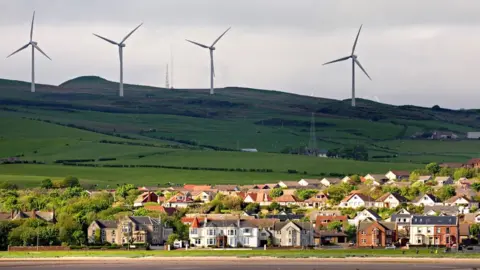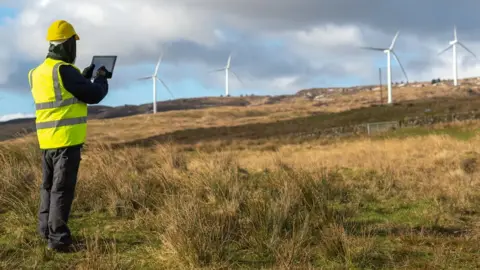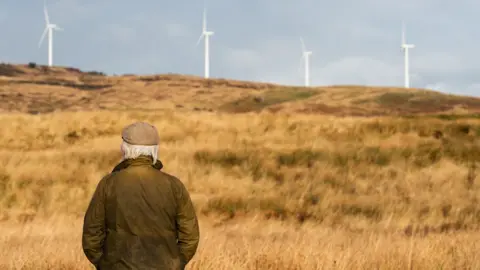Generation game: How villagers cash in on nearby turbines

 Getty Images
Getty Images- Villages across Scotland are generating millions of pounds from nearby wind farms. In the south alone, Community Benefit funds will soon rise to £12m per year, and could reach a "transformative" £700m within four decades.
- South of Scotland Enterprise has published the first study of its kind - setting out choices on how best to use the funds, favouring communities over household bills being cut. But there are questions on where the community funds should go - short term, small projects or a lasting legacy?
- The gains from the renewable energy boom will also flow from grid connections, causing controversy in rural Scotland, and communities near sub-stations and pylons can also expect to have their own share.
How much should you be compensated for living next to a windfarm? Or a very large pylon, or an electricity sub-station?
There's noise and disruption to consider from construction traffic. There can be noise from rotating blades, a hum from high-voltage cables, and you may think it spoils the view from your kitchen window.
Many have already had to face those questions, though few recipients have had much influence over the answers.
In the early days from the 1990s, while wind turbines were subsidised and not producing a financial surplus, the rewards for being a neighbour were not that generous, if there were any at all.
But now, onshore windfarms are profitable. New deals being struck with local communities are far bigger, and stretch a long way into the distance.
 Getty Images
Getty ImagesThe current controversies around the Highlands and Aberdeenshire about the cables necessary to take wind power to the customer also feature the question of compensation, to many more communities.
SSEN, which has the monopoly on grid links in the north, has been consulting on how best to pay, and how wide that compensation should be spread. How close to pylons does a village have to be?
This is not a legal requirement on developers, but the UK government was consulting earlier this year on how it might set a benchmark for contributions to those affected by grid connections.
Ministers' preference is for a voluntary agreement, with flexibility to meet local conditions, but with national guidelines and minimum expectations of deals struck. They're due to publish their guidelines by the end of this year.
The Scottish government lacks legislative powers on this, but recently struck a deal with the onshore wind sector, which includes an expectation of around £5000 per megawatt per year. For a wind turbine being installed with a 5 megawatt capacity, that means £25,000 per turbine each year, distributed around neighbouring communities.
Christmas lights
That's a long way from the funds now flowing per community. It is estimated that the south of Scotland got more than £4m in community benefits last year, at just above £2,500 per megawatt per year.
The good news for those who have had wind farms on their hilltops for the longest is that they will be the first to be retired. Much more powerful turbines are set to replace many of them in the process of 'repowering'. But as that requires new planning permission, that is the point at which to exert maximum pressure for a community windfall.
 Getty Images
Getty ImagesIf the new expectation of £5,000 per megawatt per year is to be met, it will mean a helpful sum for a small community.
There's money for maintenance of the village hall in Skirling, near Biggar. There are grants for young people of up to £250. For bigger grants, of up to £5000 per student, or up to £25,000 per community project, you have to apply to the trust set up by the operators of the vast, nearby Clyde wind farm.
A training bursary fund pays up to £1500 to young people in Kelloholm, Kirkconnel and Sanquhar in Dumfriesshire, where the high school plays a part in deciding on the distribution.
Wind farms fund improved changing facilities, a tractor and kit for local football and bowling clubs, equipment for the Nithsdale Times, Christmas lights, and help to pay for an enterprise development officer.
"Transformative"
Across rural Scotland, this has pumped money and a bit more life into community councils. And that influx of funds all adds up.
For the south of Scotland, it adds up to nearly £700 million by 2058. That's the forecast of an economic study commissioned by South of Scotland Enterprise from the Biggar Economics consultancy and published on Tuesday.
It finds that more than £30m has been distributed across Dumfries and Galloway and Scottish Borders council areas over the past 25 years.
From that modest start, it is forecast that £12m per year could be generated by the mid-2030s. And looking a long way out to 2058 - the end of the lifespan of windfarms now being planned - it reckons that community benefits could rise steeply that decade to £70m per year.
It's seen as a "transformative" opportunity for the south of Scotland. The total is reckoned at six times the scale of the Borderlands growth fund.
And the southern counties have little more than a fifth of the Scottish total of onshore windfarms.
Disruption fee
So the question arises of how best to spend that money. Labour's Shadow Chancellor, Rachel Reeves, recently said the party will push through delayed projects that are needed for grid connections and it is reasonable to lower the bills of people affected by that. (That's in England - Scotland does planning differently, but with some similar problems.)
The direction of travel for other consultations is away from individual household benefit, through bills, and towards communities getting the funds.
Professor Russel Griggs, chair of South of Scotland Enterprise, suggests there could be three payments. The first is a lump sum to help communities organise, so that they can gather opinion and negotiate effectively. A significant brake on this process is from the shortfall of capacity to absorb funds and to organise projects that would use them.
It is important, also, to get communities working together. The Blackridge wind farm in Kirkcudbrightshire (Dumfries and Galloway) has 23 turbines and 59 megawatts of capacity. It distributes £250,000 per year to nearby communities, which have ten different community councils. Getting agreement between them on a plan, including the creation of the Glenkens and District Trust, was quite a feat of community politics.
 Getty Images
Getty ImagesA second fee could be paid to compensate those who live with the disruption from construction trucks coming through the village. And then there would be an annual payment, based on the output or the capacity of the windfarm.
Biggar Economics found there are 52 windfarm sites in the south of Scotland, and three-quarters of them have community benefit funds. These are distributed in Dumfries and Galloway to 86 community councils.
The spread is not even. In the south-west, the highest concentration is the council wards of Annandale and Eskdale, in Mid and Upper Nithsdale and in mid-Galloway and Wigton West. There's a correlation between community benefit and low incomes.
In Scottish borders, there are 20 community councils that get funds, with the main focus in Berwickshire, and no such income correlation.
Consumer investors
It is in that county you can find new models of getting funds out of the wind power boom. The Fishermen Three is a three-turbine windfarm, rated at 7.5 megawatts, developed by Berwickshire Housing Association and Community Energy Scotland.
So while taking the investment risk, they also get the profit, and the housing association reckons that can help fund 500 new homes in its area, while the energy trust gets £10m from the project, to reinvest elsewhere.
A more dispersed community will benefit from the profits generated near Kirkoswald in Ayrshire, when the construction of eight turbines on Kirk Hill, which is now under way, leads to a stream of revenue.
Some 5600 investors from across the UK - residential and business - have crowdfunded that windfarm through Ripple Energy, the developer, which then supplies them with low priced green electricity. It claims to be the UK's largest consumer-funded wind farm.
A question asked by some of the developers, according to Biggar Economics, is whether small scale projects are the best way to spend this money, or if there is a case for a more strategic approach, aimed at a lasting legacy.
The recommendation of this report is that it has to be local communities that decide the answer to that.
They might wish to ask those who have had 50 years of the oil and gas industry as neighbours, to find out how to make the most of it.
